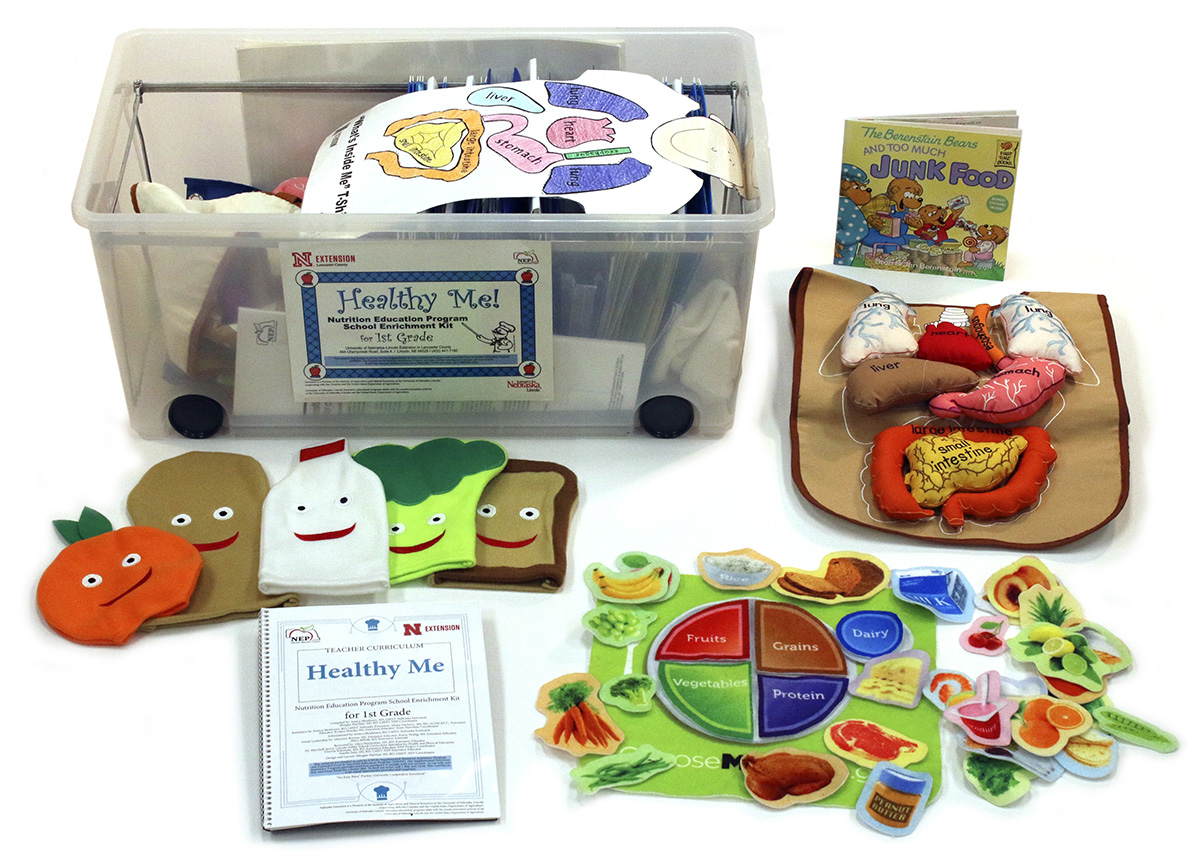
By Alyssa Havlovic, MS, RDN, ACSM EP-C and Kristen Houska, MS, Extension Educators
The Nutrition Education Kit program is a statewide Nebraska Extension school enrichment program developed for grades K–5 that teaches students about health, nutrition and physical activity. The kits include lessons and supplies for grade-specific, hands-on learning activities.
In Lincoln, this program has been implemented in Lincoln Public Schools (LPS) for nearly two decades in the schools who qualify for Supplemental Nutrition Assistance Program Education (SNAP-Ed) — meaning, 50 percent or more of their students qualify for reduced or free lunch.
In 2011, Nebraska Extension received a USDA grant which allowed for expansion of the program to all LPS schools in grades K–2 and in the fall of 2017, a Nebraska Team Nutrition (TN) grant funded expansion of the program to all K–5 classrooms in LPS.
WHAT IS A NUTRITION EDUCATION KIT?
The Nutrition Education Kit program is a unique, evidence-based approach to teaching health. The kits meet LPS health curriculum objectives required for each grade’s nutrition unit. The kits also meet national health standards and are now delivered by Nebraska Extension to schools in 11 other counties.
Grade-specific lessons cover the following topics: MyPlate, nutrients, meal-planning, the importance of breakfast, healthy snacking, food safety and physical activity. Lessons for the higher grade levels build upon the concepts taught in the younger grades. For example, in grades K–2, students learn about MyPlate and the importance of eating a variety of foods from each food group. In grades 3–5, students dive deeper into the nutrients in food and why our bodies need them.
Participating classrooms spend an average of 5–6 hours using the kits to teach nutrition and physical activity to youth grades K–5 through Extension team members and teachers.
CLASSROOM TEACHING
Extension staff visit each classroom and teach the students an introductory lesson, which often focuses on food safety — specifically hand washing. Students have an opportunity to see where germs might be on their hands and then practice using proper handwashing steps to clean them.
The teacher then utilizes the nutrition education kit in the classroom for a period of three weeks. At the end of the nutrition unit, Extension staff return to the classroom to teach a final lesson about healthy snacking which includes preparing a healthy snack together or participating in a physical activity.
PROGRAM REACH AND IMPACT
In the 2017–18 school year, the Nutrition Education Kit program reached 15,992 LPS Elementary students in grades K–5.
Pre- and post-nutrition knowledge and behavior evaluations are administered in each classroom to measure program impact. Based on these evaluations, significant improvements in students’ nutrition knowledge were found in all grades:
• Kindergarten students improved by 36%.
• 1st graders improved by 34%.
• 2nd graders improved by 35%.
• 3rd graders improved by 18%.
• 5th graders improved by 56%.
• 4th grade students were asked a behavioral question about reading a food label and how frequently they eat breakfast, but responses did not change significantly from pre- to post-evaluation.
TEACHER FEEDBACK
“I wanted to tell you how wonderful the nutrition kits were for fourth grade and how excited the kids were for all the activities! They said it was the most fun they have had in health. That made me very excited to hear.” —Eastridge 4th grade teacher
“I just wanted to provide positive feedback from the nutrition unit. It was a great unit. My students were engaged with the group work of sorting cards, reading labels etc. The moldy bread experiment was simple yet relevant to their lives.” —Meadow Lane 4th grade teacher
“The kids love all the interactive demonstrations and activities/experiments/presentations. I also thoroughly enjoy the kits — they really make it enjoyable to teach since there is very little prep to do. We wish we had more kits like these to go along with our curriculum.” —Clinton 2nd grade teacher
“Love the hands-on opportunities and lessons. We appreciate having enough for all students. We really enjoy using the nutrition kit and look forward to receiving it every year!” —McPhee kindergarten teacher
“The kit makes this my favorite health unit to teach! All children can be successful! Thank you.” —Saratoga 1st grade teacher
“This timing worked great — we had our school-wide health and wellness week while we had our kits! :) Ms. K [Extension staff member] is a fabulous teacher!” —Norwood Park 1st grade teacher
“Excellent curriculum development that fits well with LPS objectives. Students enjoy and learn — thank you!!” —Brownell 1st grade teacher
“It’s a wonderful teacher- and student-friendly program. Thank you! We enjoyed our presentations from the Extension.” —Campbell 4th grade teacher